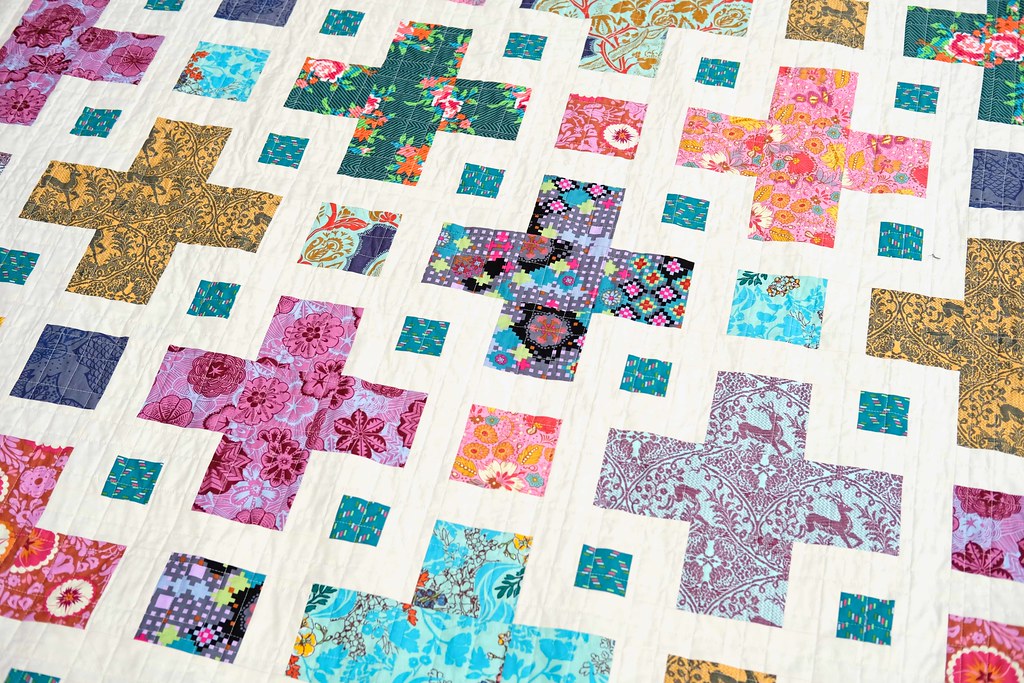
The Violet QAL Week 2 - Cutting Your Fabric (General Tips and Info)
Thank you for continuing with the Violet QAL! I loved seeing all of your posts last week and I am so excited about the variety I saw in the fabric pulls. This is going to be so much fun!
Generally when I make a quilt, I don't plan the layout ahead of time. For this quilt, I highly recommend downloading the free coloring sheet in my shop and doing some preliminary planning. You can make adjustments as we sew everything together, but this will help distribute your fabrics throughout your quilt (and as you will discover next week - which fabrics to use in the blocks and which to use in the sashing).
This applies to the non-rainbow version - As it's written, the pattern has you cut the same number of squares for each fat quarter for Fabric A. No matter which size quilt you are making, you will have a few squares leftover. It is written this way to give you flexibility in where you place your fabrics in your quilt. If you plan ahead, you can figure out how many squares you need from each FQ and save yourself a little fabric. Or just follow the pattern and put the extra squares in your scrap bin (that's what I will do).
Instagram post idea for this week - show us your fabric all cut out and ready to go! This is also a great time to ask questions about cutting fabric or share your own tips.
Note - there is a minor typo in the printed version of the pattern. Right before I printed the pattern I added a note that depending on your layout, you might need to cut a 13th square from one of your fat quarters. It says "you will need a 13th square from some more fat quarters" and it should say "you need a 13th square from 1 or more fat quarters."
Cutting Fabric - Tools
You know I am a minimalist when it comes to "sewing stuff" (obvs not a minimalist when it comes to buying fabric). All you need is a cutting mat (I have the green version of this one but I'm linking to the navy one because I WISH I had that one), a rotary cutter (fresh blade please!), and a ruler.
When I am cutting fabric for a project, I use one of two rulers:
- 8.5" x 24.5" Creative Grids ruler - I upgraded to this ruler last year and it is THE BEST! If you only have one ruler, this is the one I would suggest.
- Stripology XL Ruler - When I first saw this ruler, I thought it was gimmicky and expensive, but then a friend sent me one (not the XL one, the original one) and then I understood. The original version was just a little bit too short to make it easy to cut WOF (width of fabric) strips, but the XL is perfect. I make A LOT of quilts which means I cut A LOT of fabric and it really does save you time. If you are wanting to speed up your fabric cutting, I do think it is worth it.
 Tips
Tips
- Press your fabric before you cut it. I know it seems like it is just an extra step, but it will help make your cutting more accurate.
- Stack your fabrics to speed up cutting - you can cut through 4 layers of fabric accurately if your rotary blade is sharp. There is a lot to take into account when you are cutting fabric - if you are looking for tips, this video is helpful!
- When cutting your background fabric, cut the largest pieces first. You will likely end up with leftover pieces after cutting these - use these to cut the smaller pieces before cutting into your yardage.
- Borders are optional! Only 2 out of all of my patterns have borders because I hate sewing them. For this pattern, I think they add something so I always include them when I make this quilt. But, if you don't want to have borders, you do not have to add them. You can also make them a little bigger if you want to increase the size of your quilt. Note: if you skip the borders, the baby size quilt will be 36" x 42", the lap size will be 54" x 64", and the twin size will be 64" x 84".
- Label your fabric pieces so they are easier to keep track of (especially the background pieces). I just use mini post-it notes.
- This is optional but I think it can be particularly helpful for newer quilters - before you cut everything out, make a full test block. This will let you know if you are cutting accurately or if your seam allowance is off. This pattern isn't difficult to be piece, especially because there aren't very many seams to line up, but accuracy always pays off.




